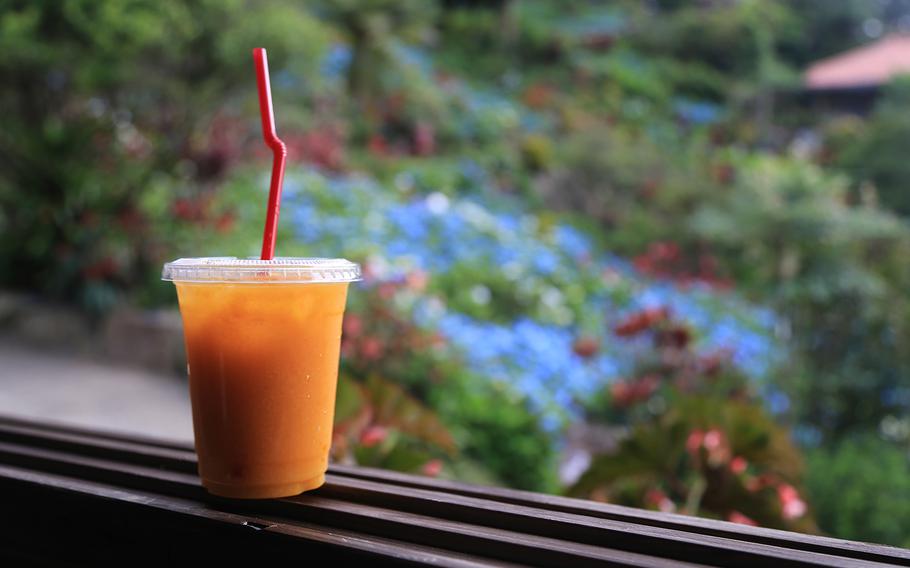
Fresh tankan-tangerine juice is made from locally grown tangerines and served at a small cafe at Yohena Hydrangea Garden on Okinawa. (Aya Ichihashi/Stars and Stripes)
After Golden Week, Okinawa usually marches into tsuyu, or rainy season, which lasts until late June.
For some, the gloomy sky and constant rain makes them feel blue. Others may appreciate the little break from the blazing sun, because after the rainy season is over, Okinawa is officially in summer.
As for me, as soon as the Japan Meteorological Agency announces that Okinawa is in rainy season, it’s time to hit the road to the Yohena Hydrangea Garden to see some pretty flowers.
Located in the Izumi neighborhood of Motobu, the garden’s 10,000 hydrangeas welcome visitors from around the world. During the peak season, as many as 300,000 flowers can be seen there.
The founder, Uto Yohena, originally tended a tangerine grove. At age 60, she started the garden with just a few hydrangeas from a relative. She kept expanding her hydrangea garden and soon the hydrangeas took over the field.
In 2001, she opened her garden for everyone to enjoy.
Now the garden offers as many as 40 types of hydrangeas and 100 species of other flowers, including begonia, Medinilla maginifica and bird-of-paradise.
When I visited last week, the gardenia was fully bloomed and spreading its amazing scent.
May 20 to early June may be the peak season for hydrangeas this year; however, it all depends on the weather, and you can visit a few times during the season.
I make it a tradition to visit the garden during the rainy season, which gives me a reason to look forward to the rain, rather than complain about it.
When I pull up to the parking lot and sneak a peek of the garden from outside, my heart jumps every time. The layers of greens, blues, purples and pinks seem to reach out and grab me. If it’s raining, it’s even better, because the rain drops make the blues even bluer and the greens even greener.
The soil composition determines the color of the hydrangea flower. If the soil is acidic, the flower turns blue; but if the soil is neutral to alkaline, the flower turns pink.
Because of this, you can have both pink and blue hydrangeas by changing the soil.
The garden sells small potted hydrangeas for you to take home.
After walking through the garden and seeing the beautiful flowers, I am ready for some fresh tankan-tangerine juice, made from locally grown tangerines and served at a small cafe. It’s available only during the hydrangea season.
The tankan juice is so refreshing and delicious, especially while contemplating the amazing view from the cafe.
Seated there, I cannot help but look for Ms. Uto in the garden. I loved to see her chatting with visitors or greeting guests with her gentle smile.
Unfortunately, Ms. Uto died in April last year, after a fulfilling 100 years of life, including nearly four decades nurturing her beloved flowers. Her family is now taking care of the garden and carrying on her accomplishment and legacy.
DIRECTIONS: Address: 1312 Izumi, Motobu, Kunigami District, Okinawa 905-0221
TIMES: Open daily, 9 a.m. to 6:30 p.m. This year the garden will be open until late June.
COSTS: 400 yen (about $3.60) for adults; 200 yen for elementary through high school students. Free parking.
FOOD: Shaved ice 250 yen, passion fruit juice 350 yen, tankan tangerine juice 350 yen
INFORMATION: Online: ohenaajisaien.sakura.ne.jp/index.html
Note: Shoes with heels aren’t recommended. The ground might get slippery from rain; and there are some hills throughout the garden.